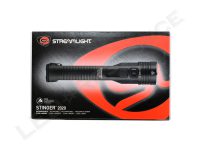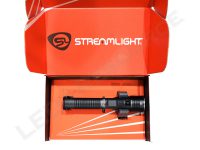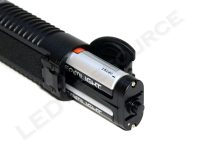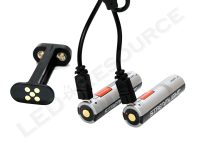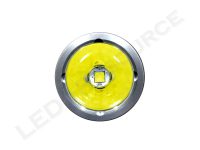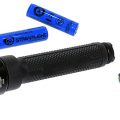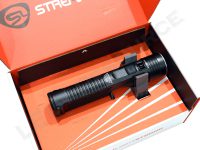 As the first major upgrade to the Stinger LED family in more than a decade, the Streamlight Stinger 2020 introduces several new features including a reshaped body with anti-roll design, mode selector switch, battery status indicator, and higher capacity lithium-ion battery pack. We previously looked at the Stinger DS LED HL back in 2013, when the NiCd battery was just being replaced with NiMH, so let’s take a look at the latest evolution of this light and see how these changes compares with the last generation. In our new Quick Test review format, we will be taking a look at the performance of the Stinger 2020 with a focus on technical details.
As the first major upgrade to the Stinger LED family in more than a decade, the Streamlight Stinger 2020 introduces several new features including a reshaped body with anti-roll design, mode selector switch, battery status indicator, and higher capacity lithium-ion battery pack. We previously looked at the Stinger DS LED HL back in 2013, when the NiCd battery was just being replaced with NiMH, so let’s take a look at the latest evolution of this light and see how these changes compares with the last generation. In our new Quick Test review format, we will be taking a look at the performance of the Stinger 2020 with a focus on technical details.
Key Specifications
- Output: 2,000 lumens high, 850 lumens medium, 100 lumens low
- Runtime: 2h high, 4h medium, 24h low
- Battery: 2 x SL-B26 Li-Ion Rechargeable Battery Pack
- Length: 7.7″
- Diameter: 1.6″ head, 1.6″ body
- Weight with Batteries: 12.3 oz.
- Colors: Black, Red, Blue
- Warranty: Limited Lifetime
- MSRP: $225-265
- Actual Pricing: ~$140-180
Packaging
Streamlight offers various packages for their rechargeable lights with choices for input voltage and charging options. The Stinger 2020 can be ordered with just a Micro USB “Y” cable for charging or with a Stinger family charger that takes Micro USB or 12V power.
Batteries
The Stinger 2020 uses a battery carrier with two SL-B26 2,600mAh lithium-ion batteries, which are rated for 500 cycles, in parallel. Although this means that older Stinger family batteries cannot be used, the Stinger 2020 can still be charged with existing Stinger chargers. In addition, the SL-B26 batteries can also be charged independently using the built-in Micro USB port, in a battery charger such as the 2-unit charger (#22100), or with the newly released PiggyBack charger (#78119).
Charge time is 8 hours with the cradle using Micro USB, 6 hours with the cradle using 12V supply, or 5 hours with the Micro USB port on the SL-B26 batteries, unless limited by the USB power supply.
Modes
The mode select switch on the head of the light eliminates the need to cycle through output levels and ensures that the selected mode will always be used. Both head and tail switches can be used independently.
Mode Select: Low-Medium-High
Use the labeled switch to select the output level from Low on the left to High on the right. Detents will make an audible click between settings.
Two Fast Clicks: Strobe
With two fast clicks, the maximum output strobe is activated. Strobe can be activated anytime, even if the light is already turned on.
Performance
Using a Cree XHP50.2 multi-die LED, the Stinger 2020 is capable of producing more output but the large area of the multi-die LED results in a considerably wider hotspot that lacks range for distant objects. For example, medium output on the Stinger 2020 is comparable to maximum output on the Stinger DS LED HL but with only half the peak beam intensity.
Runtime
If you haven’t read our article about runtime graphs and the ANSI FL1 Standard, please click here.
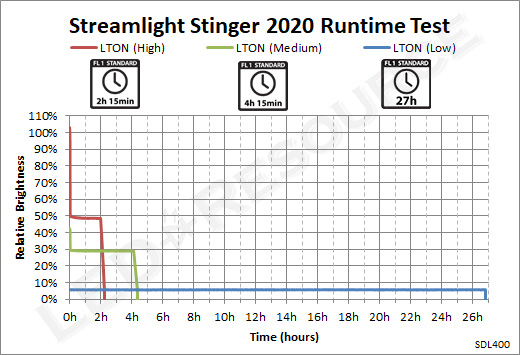
Streamlight uses step-down regulation in the Stinger 2020 and the rated output on high or medium output is only maintained for the first two minutes. Most of the runtime is at ~1000 lumens for high output or ~600 lumens for medium output, which makes the overall performance much closer to that of the Stinger DS LED HL than the specs would suggest.
Conclusion
There is one major problem with the Stinger 2020 that existing Stinger LED owners will immediately notice – both switches are a lot harder to click for constant on. The head switch has a stiff rubber cover that barely protrudes from the light. The tail switch has a similar problem because the battery cover is flat and no longer round, making it harder to reach with your thumb. Considerable force needs to be used and the square shape of the buttons doesn’t help either. The round switches on Stinger “DS” models are just easier and more comfortable to use.
To Streamlight’s credit, the runtime graph on the Fact Sheet does illustrate the step-down behavior that is evident with the maximum output, but the claimed 2,000 lumens is more like a burst mode as it quickly drops to 50%. Medium will be the most versatile mode on the Stinger 2020 and it is almost identical to high on the Stinger DS LED HL, but this is where we find the biggest benefit of the Stinger 2020 – much longer runtime. With the new mode select switch and up to 24 hours in low mode, it’s easy to change between modes and get significantly more runtime for longer jobs, outdoor activities, or power outages at home. The wider beam pattern from the larger LED also reduces glare when reflections can be a problem, for example in the automotive sector.
One of the best features of the Stinger 2020 is the mode select switch, which makes accessing lower output modes easier and faster by not having to cycle through output levels. The new battery pack effectively doubles the capacity of existing Stinger batteries while also reducing weight compared to NiMH, plus the built-in Micro USB charging port on the batteries makes it possible to charge on the go without having to bring a cradle (although you may still need the Micro USB Y cable to charge both batteries at the same time).
If you have a standard Stinger LED model, the Stinger 2020 will be an excellent upgrade and a noticeable step up in performance, but if you already have an “HL” model, difference will be mostly just increased runtime. For long-range illumination needs, the Stinger 2020 lacks peak beam intensity and one of the Stinger “HPL” models will still be a better choice. It’s good to see that Streamlight offers multiple versions of the Stinger for different use cases so we don’t see the Stinger 2020 replacing all existing models just yet, but hopefully the next iteration will have improved switches and USB C charging would be welcome too.
Related Links
Streamlight Stinger 2020 Product Page

